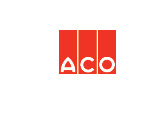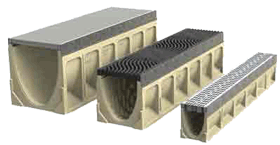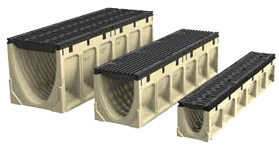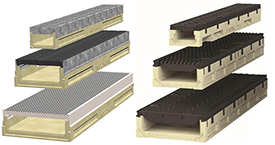 |
||||||||||||||||||||
ACO Drain
|
 |
|||||||||||||||||||
hh
|
| Mechanical Properties | Cement Concrete |
GRC |
HDPE |
|
| Compressive strength The trench body is subject to compressive loads in use and needs to withstand the specified load. |
25MPa |
96MPa C-579 |
50MPa |
58MPa D-695 |
| Flexural strength Affects site handling and when trench body is in areas where encasement and soils are suspect. |
3MPa |
27MPa C-580 |
12MPa |
15MPa D-790 |
| Tensile strength Not generally required in trench bodies, but relevant to grates. Used as material measurement. |
2MPa |
21MPa C-307 |
5.5MPa |
14MPa D-638 |
Maintenance
- Compared with GRC pits, Polycrete
 Pits are easy to keep clean due to the smooth and void free walls. This is particularly important in hygienic applications. Additionally, in the external environment, they are unaffected by biological attack i.e. there is no need to continuously remove vegetation that may otherwise grow on concrete based products such as GRC.
Pits are easy to keep clean due to the smooth and void free walls. This is particularly important in hygienic applications. Additionally, in the external environment, they are unaffected by biological attack i.e. there is no need to continuously remove vegetation that may otherwise grow on concrete based products such as GRC.
Porosity
- Compared with GRC pits, Polycrete
 Pits have an extremely low porosity (0.07% v. 12%-GRC). This is important when grated pits are used in sensitive areas i.e. protecting the environment from contamination from the liquid in the pit (oils, toxins and other contaminants)
Pits have an extremely low porosity (0.07% v. 12%-GRC). This is important when grated pits are used in sensitive areas i.e. protecting the environment from contamination from the liquid in the pit (oils, toxins and other contaminants)
Chemical resistance
- Due to the resin binding agent used, Polycrete
 Pits offer a higher resistance to chemical and weathering attack than GRC, ensuring pits have a superior life cycle. In aggressive environments, GRC is prone to deterioration, particularly in alkaline soils. Therefore, GRC pits require regular maintenance and in some cases are susceptible to early failure.
Pits offer a higher resistance to chemical and weathering attack than GRC, ensuring pits have a superior life cycle. In aggressive environments, GRC is prone to deterioration, particularly in alkaline soils. Therefore, GRC pits require regular maintenance and in some cases are susceptible to early failure.
Quality
- Polycrete
 Pits have smooth high quality walls. Modular components come from matched precision tooling for consistent quality. In contrast, GRC pits have rough walls of inconsistent quality.
Pits have smooth high quality walls. Modular components come from matched precision tooling for consistent quality. In contrast, GRC pits have rough walls of inconsistent quality.


 300mm internal width
300mm internal width 300mm
internal width
300mm
internal width



 ACO RESOURCES
ACO RESOURCES